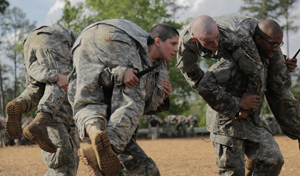
As military opens opportunities, veterans community needs to be ready
At the beginning of 2013, then-Department of Defense Secretary Leon Panetta lifted the ban on women in combat roles and gave the military two years to complete integration. In 2015, two women successfully completed Army Ranger School, leading to a Pentagon decision calling for combat specialties be open to women. The following year, one of those women—Army Capt. Kristen Griest—became the first female infantry officer in American history.
As the role of women in the military expands, during Women’s History Month the veterans community recognizes former and current trailblazers who have made and are making history. Since the Revolutionary War, countless military women have served and sacrificed. While thousands of groundbreaking women have come before, those serving today are breaking barriers and making their mark on modern military history.
By late 2018, the infantry had 51 female officers and 253 women in the enlisted ranks, according to the Army.
As more and more women fill roles previously unavailable to them, the number of women in the armed services—and subsequently the veteran population—is rapidly increasing. According to DOD, women now make up 20 percent of the Air Force, 19 percent of the Navy, 15 percent of the Army and almost 9 percent of the Marine Corps.
According to the Department of Veterans Affairs, 10 percent of the current veteran population are now women, the fastest-growing demographic. The number of women veterans treated at the VA almost tripled between 2000 and 2015. As a result of this rapid growth, the VA experienced difficulty meeting the clinical needs of women veterans at all sites of care.
“As we learn more through VA research about the impact of military service on the physical and mental health of women veterans and their specific needs, continued adjustments in federal programs and policies and new legislation will be needed to address the programmatic gaps,” said National Legislative Director Joy Ilem. “There’s a culture shift happening in today’s military, led by women trailblazers. These women need VA to be prepared for them not just today, but for future generations of women veterans.”
In 2018, DAV released a comprehensive new report, Women Veterans: The Journey Ahead, based on the quality of programs and services currently available to women veterans, as well as recommendations for shaping the VA culture and system to better serve this population.
“It’s critical to remember that women aren’t just small men,” said Ilem. “Women’s body proportions and hormonal makeup are different.”
After Army veteran Brenda Reed had to have her leg amputated as the result of injuries sustained during her military service, she experienced firsthand that VA was not as prepared to help a woman veteran amputee as they should have been.
“I got my first prosthetic six weeks after the amputation, and I didn’t have any problems learning to walk on it,” said Reed. “But it was getting the right fit, which still isn’t good. I was under the impression I would be able to get a [prosthetic] foot for my size that looked similar, and it was just the opposite.”
Reed was given a prosthetic foot designed for a male. As a solution to the poor fit, the VA opted to shave off parts of the prosthesis rather than provide her with one created for women.
“I was told [by the VA tech] I was the only woman that he had seen and he wasn’t exactly sure what to do because he had never done prosthetics for women,” Reed said. “I told him it shouldn’t be any different from doing it for a man. A fit is a fit. If it doesn’t fit, it isn’t right.”
The VA is trying to implement new policies to address the barriers women veterans using their services face, and created the Center for Women Veterans as a resource to help them navigate the system. However, Ilem said, they need to look at what’s happening in today’s military and the long-term impact of that service on their physical and mental health so they are prepared to meet the future needs of women veterans.
“When women raise their right hands and swear to support and defend the Constitution of the United States, they understand it could mean sacrificing their lives,” said National Commander Dennis Nixon. “Military service requires placing this duty above their personal well-being. Unfortunately, the sacrifices they make are not always recognized or acknowledged, and women work hard to reconcile their societal roles as caregivers, mothers and wives with the warriors they are.”
“Women experience military service differently than men and have different post-deployment challenges and distinct health care needs,” added Ilem. “They also rightly expect VA health providers and benefit representatives to have expertise in women’s health and to be knowledgeable about their military service.”

